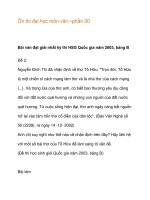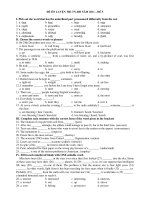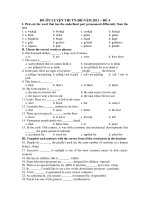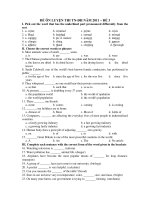LUYỆN THI ANH VĂN TN- ĐH NĂM 2011 – ĐỀ 3 ppt
Bạn đang xem bản rút gọn của tài liệu. Xem và tải ngay bản đầy đủ của tài liệu tại đây (57.66 KB, 3 trang )
LUYỆN THI ANH VĂN TN- ĐH NĂM 2011 – ĐỀ 3
I. Choose the word whose underlined part is pronounced differently from that of the others (1m)
1. A. photographs B. books C. concerts D. songs
2. A. needed B. stopped C. practiced D. watched
II. Choose the best answer A, B, C or D for each of the following sentences.:(2 m)
3. Deserts are also classified by their ________ location and dominant weather pattern.
A. geographical B. aerial C. sandy D. facial
4. Deserts take ________ one-third of the Earth's land surface.
A. up B. on C. over D. after
5 ________ Sahara of ________ Africa is the world’s largest desert.
A. / the B. the / C. a / an D. the / an
6. Deserts can be defined as areas that receive ________ average annual precipitation of less than 250
mm.
A. a B. an C. the D.
III.Add so, but, therefore, however, because, although where appropriate (2ms)
1. My brother didn’t learn hard last year; __________ , he couldn’t pass the final exam.
2. I want to work as an interpreter in the future, ________ I am studying Russian at university.
3. I understand your point of view. ___________, I do not agree with you.
4. When she got the news from her family, she could not do anything, ________ cry.
IV. Complete the sentences, using need, must, may, mustn’t, needn’t (2ms)
1. I am not deaf. You _______ shout.
2. Be careful of the dog. It__________bite you.
3. Peter has working for 10 hours. He ____________be very tired now.
4. Nam gave me a letter to post. I __________ remember to post it.
V. Read the passage and answer the questions.
The Pijantjara people have lived for thousand of years in the West Desert of Australia.
A plateau about three metres high covering an area larger than France and Italy put together, the land is
crossed by sand dunes, the rocks and soil are bright red, spinifex and desert grasses grow everywhere and gum
trees flourish along the gullies.
A prominent feature of the Western Desert is “ Lake Disappointment” – an enormous salt lake which is
dry most of the time. Aboriginal people never visit the lake fearing it is the home of canibal being.
The Desert people are made up of hundred different groups who speak a variaty of dialets but can understand
each other. Marrige patterns, family ties and religious ceremonies are very similar throughout the desert.
There are over fifty edible plants in the Western Desert as well as emus, kangaroos, snakes, lizards and
insects. The bush tomatoes is an important food. It is dried, skewered on sticks and soaked before eating.
The availability of water dominates the way life is lived in the Western Desert. The aboriginal people are
careful not to over-use the main sources and take steps to preserve springs and wells by covering them from
the sun. Small bands of people move from one source of water to another and regroup when their supplies
diminish. They also gather for ceremonies and exchange but only when the area has sufficient to support a
large gathering.
The tools carried by the desert people are lightweight and multi-purpose. Women carry large wooden dishes
and a small smooth stone which is used with large gringing stone for crushing seeds. Men carry spears, a spear
thrower, a club, and a small knife made of sharpened stone.
*Questions:
1. How long have the Pijantjara people lived in the West Desert of Australia?
_________________________________________________________________
2. How large is the Western Desert?
___________________________________________________________________
3. What are the main features of the desert people, their languages and social patterns?
______________________________________________________________________
4. Name the plants and animals mentioned in the passage.
_____________________________________________________________________
5. What do desert women carry?
_____________________________________________________________________
6. What do desert men carry?
______________________________________________________________________
Fullname:_______________________ 3
rd
ONE-PERIOD TEST
Class: 12C_______
I. Choose the word whose underlined part is pronounced differently from that of the others (1m)
1. A. friends B. reads C. banks D. brothers
2. A. explained B. arrived C. phoned D. missed
II. Choose the best answer A, B, C or D for each of the following sentences.:(2 m)
3. Almost half of turtles and tortoises are known to be threatened with ___________.
A. extinct B. extinction C. extinctive D. extinctly
4. Deserts are often composed of ________ and rocky surfaces.
A. water B. trees C. oil D. sand
5 ________ Sahara of ________ Africa is the world’s largest desert.
a. / the b. the / c. a / an d. the / an
6. Deserts can be defined as areas that receive ________ average annual precipitation of less than 250 mm.
III.Add so, but, therefore, however, because, although where appropriate (2ms)
1. My brother didn’t learn hard last year, __________ he couldn’t pass the final exam.
2. I want to work as an interpreter in the future, ________, I am studying Russian at university.
3. I am going shopping for food this evening ________ I do not have to go at the weekend.
4. When she got the news from her family, she could not do anything, ________ cry.
IV. Complete the sentences, using need, must, may, mustn’t, needn’t (2ms)
1. I am not deaf. You _______ shout.
2. Be careful of the dog. It__________bite you.
3. Peter has working for 10 hours. He ____________be very tired now.
4. Nam gave me a letter to post. I __________ forget to post it.
V. Read the passage and answer the questions.
The Pijantjara people have lived for thousand of years in the West Desert of Australia.
A plateau about three metres high covering an area larger than France and Italy put together, the land is
crossed by sand dunes, the rocks and soil are bright red, spinifex and desert grasses grow everywhere and gum
trees flourish along the gullies.
A prominent feature of the Western Desert is “ Lake Disappointment” – an enormous salt lake which is
dry most of the time. Aboriginal people never visit the lake fearing it is the home of canibal being.
The Desert people are made up of hundred different groups who speak a variaty of dialets but can understand
each other. Marrige patterns, family ties and religious ceremonies are very similar throughout the desert.
There are over fifty edible plants in the Western Desert as well as emus, kangaroos, snakes, lizards and
insects. The bush tomatoes is an important food. It is dried, skewered on sticks and soaked before eating.
The availability of water dominates the way life is lived in the Western Desert. The aboriginal people are
careful not to over-use the main sources and take steps to preserve springs and wells by covering them from
the sun. Small bands of people move from one source of water to another and regroup when their supplies
diminish. They also gather for ceremonies and exchange but only when the area has sufficient to support a
large gathering.
The tools carried by the desert people are lightweight and multi-purpose. Women carry large wooden dishes
and a small smooth stone which is used with large gringing stone for crushing seeds. Men carry spears, a spear
thrower, a club, and a small knife made of sharpened stone.
*Questions:
1. How long have the Pijantjara people lived in the West Desert of Australia?
_________________________________________________________________
No.
2. How large is the Western Desert?
___________________________________________________________________
3. What are the main features of the desert people, their languages and social patterns?
______________________________________________________________________
4. Name the plants and animals mentioned in the passage.
_____________________________________________________________________
5. What do desert women carry?
_____________________________________________________________________
6. What do desert men carry?
______________________________________________________________________









